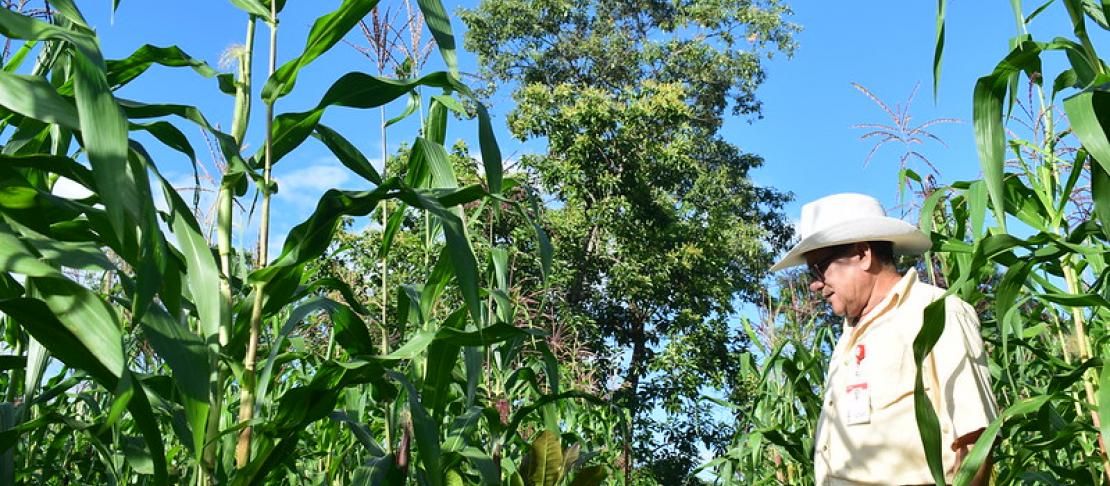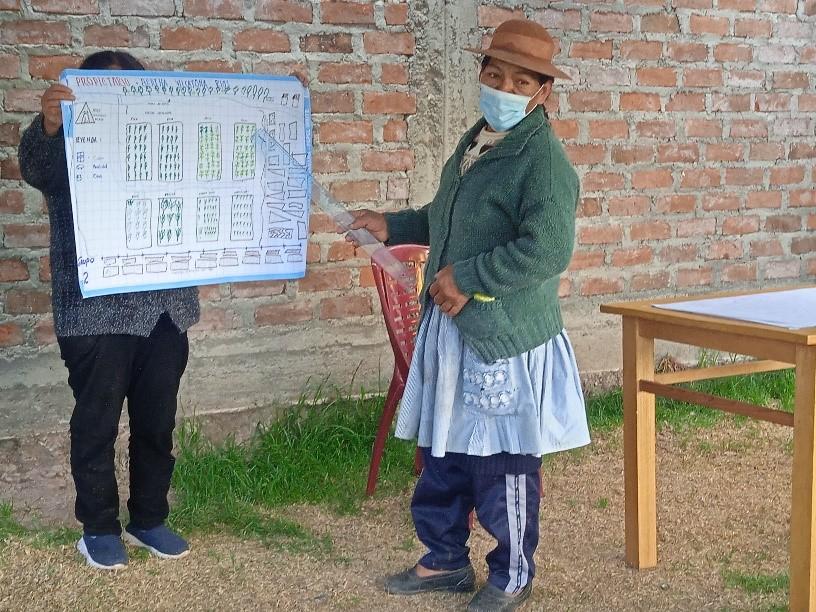Scaling up participatory climate services in Latin America

The impact of climate change and variability on agricultural production in Latin America—a region that contributes around 14% of world food production—is undeniable.
According to the Food and Agricultural Organization (FAO) and the World Food Programme (WFP), Central America faced severe periods of drought in six of the last ten years (2014-2019), affecting more than half of Latin America’s small-scale basic grain producers. As a result, a transition towards more climate-smart agriculture practices has become increasingly urgent.
Promoting the development of such practices in vulnerable areas must, among other things, involve helping farmers manage the risks associated with climate hazards by providing access to timely and understandable information that supports decision-making in the field. This will help farmers safeguard their livelihoods and food security, increase productivity and adapt to a changing climate. Despite significant progress in the co-production of agroclimatic information in the region, transferring accessible climate information to farmers quickly and efficiently remains a challenge.
At the CGIAR Research Program on Climate Change, Agriculture and Food Security (CCAFS), we have been implementing the Participatory Integrated Climate Services for Agriculture (PICSA) approach. This aims to empower field professionals, technicians, and farmers with useful tools that empower them to make decisions based on site-specific climate information. PICSA has proven to be a very successful mechanism for going the “last mile to the producer” and several countries have now started to adopt this methodology.
PICSA for climate action in Colombia, Ecuador, and Peru
One project that has made successful use of the PICSA approach is called: “Agroecology for climate action in Latin America: Strengthening the evidence for a climate-resilient and low-carbon small-scale agriculture”, and was developed by CCAFS in partnership with the Alliance of Bioversity International and CIAT, International Potato Center (CIP’s) Andean Initiative, French National Research Institute for Sustainable Development (IRD), and the French agricultural research and international cooperation organization (CIRAD). Its objective is to generate evidence on the contributions of agroecology, a holistic approach to the design and management of sustainable agriculture and food systems, to climate resilience and low carbon emissions.
One of this project’s activities is a work package focused on PICSA, to support the decision-making of small farmers before and during the agricultural season. As part of this work package, CCAFS developed training workshops on agroecology methods, in collaboration with three local partners: EkoRural, Rural Support Center- Perú (CEAR), Peasant Agroecological Markets Network (REDMAC) in Ecuador, Peru, and Colombia respectively.
These workshops follow a “training of trainers” process so that a group of trained technicians can implement the methodology in the field with farmers. After that, we identify the extent to which farmers use agro-climatic information in their decision-making processes.
A first finding of the trainings is that there is a set of basic and shared agroecological practices among small farmers in Ecuador, Peru, and Colombia. These included: crop rotation (temporary), crop association (spatial), composting organic matter, mulching, and integrating livestock with crop production. These practices contribute to the mitigation of the adverse effects of the climate from the plot to landscape scale, in addition to fulfilling multiple functions that contribute to the health and resilience of soils and crops, strengthening family production for self-consumption and trade in surpluses.

A more precise understanding of crops’ water requirements
In the Central Sierra of Ecuador, EkoRural implemented the PICSA methodology in the communities of Basquitay and Tzimbuto (Chimborazo provinces), as well as Compañía Baja and Isinche de Infantes (Cotopaxi). These are Kichwa-speaking rural indigenous communities who live at altitudes of between 2800-3500 meters above sea level. This means they are subject to climatic phenomena like frost, hailstorms, and fluctuating rainfall.
In Basquitay, farmers do not have irrigation water and are totally dependent on rainfall. During the implementation period, a key insight that emerged was that planting crops based on a more precise understanding of their water requirements is key to supporting future resilience.
In Tzimbuto, on the other hand, farmers do have access to an irrigation canal, but discussions about different crops’ water needs are still vital, in order to optimize their margin.

The “options by context” exercise provoked a revealing reflection on the differences between the water, input, and labor requirements of typical crops in the Chimborazo area, such as quinoa and Andean tubers (eg, potatoes).
Due to their much lower water requirements, quinoa can be sown in months with less rainfall. In Isinche, it was confirmed that the "chocho" or lupine is very suitable according to the climatic conditions of the area. In Compañía Baja producers of the Semilla y Vida Association (EkoRural partners) concluded that diversifying their vegetable production is an achievable dream given their local resources, based on these workshops.

Women taking center stage
From the workshops held in Ecuador and Peru, one standout feature was the broad participation of women. Prioritization of economic activities outside agriculture has led to the migration of men away from farming communities, emphasizing the role of women in the field.
In the community of Pucara (in the Junín-Peru region), at more than 3,300 meters above sea level, the vegetable producers of the Goyito Ecological Garden and the Maravillosas de Asca are leading the implementation of the PICSA methodology. Vegetable production in these smallholder contexts generates modest income. However, the applied learning that the methodology brings supports the development of new skills and fundamental knowledge in a context of changing seasonal rains with limited irrigation systems. In this process, seasonal forecasts, as well as the interpretation and use of local precipitation data from the past three decades are key.
Identifying adaptable crops
In Colombia, after analyzing the precipitation patterns in the municipalities of Buga and Dagua, REDMAC found that in recent years, agricultural production in those areas had been affected by both torrential rains and periods of water shortage in recent years. During workshops, local farmers recognized that the use of new climate information is a valuable tool for decision-making on their farms. After analyzing crops in terms of their adaptability, corn was identified as potentially vulnerable, and crops such as cassava, arracacha, and various vegetables were identified as high potential crops in the area. With the support of the REDMAC project, at least 5 rain gauges will be installed on the farms of their associated producers, to promote the recording and use of meteorological information to support decision-making.
Although the Agroecology project will end in the coming months, the PICSA processes will continue to be implemented in the three countries with the leadership of the three partners. It is expected that, with the capacity transfer processes carried out so far, the approaches to climate services will escalate into new contexts. There are interesting opportunities for collaboration with universities in Ecuador; with the public sector in Peru who are currently promoting the creation of new Agroclimatic Technical Tables; and the adaptation of PICSA to the contexts of agroecological coffee growers with REDMAC in the case of Colombia.
Read more:
- Climate information and family farming: stories of three TeSACs in Latin America: https://ccafs.cgiar.org/es/news/informacion-climatica-y-agricultura-familiar-historias-de-tres-tesac-en-america-latina
- Creating opportunities for young Honduran coffee farmers in climate services: https://ccafs.cgiar.org/es/resources/publications/creando-oportunidades-para-los-jovenes-caficultores-de-honduras-en
- Agroclimatic integrated digital solutions [Project]: https://ccafs.cgiar.org/es/research/projects/soluciones-digitales-integradas-agroclimaticas
- Scaling adaptation experiences in the dry corridor of Guatemala: https://ccafs.cgiar.org/es/news/escalando-experiencias-en-adaptacion-en-el-corredor-seco-de-guatemala
- Strengthening climate services for agriculture in Latin America: https://ccafs.cgiar.org/es/news/fortaleciendo-los-servicios-climaticos-para-la-agricultura-en-america-latina
- Implementation of Participatory Integrated Climate Services for Agriculture (PICSA) in TESAC - Cauca Colombia: https://hdl.handle.net/10568/93424
- Implementation of the Monitoring of Climate-Adapted Sustainable Agriculture (ASAC) options: Follow-up of its adoption and impacts in the TeSAC of Olopa, Guatemala - February 2020 Activity Report: https://hdl.handle.net/10568/1096


